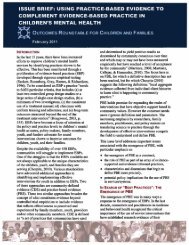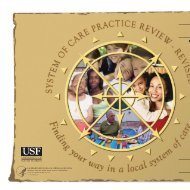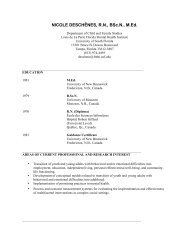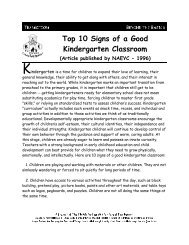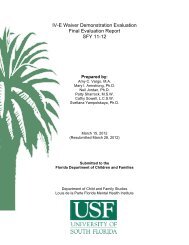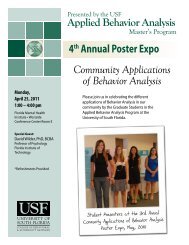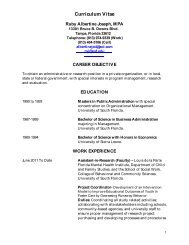The Early Learning Opportunities (ELO) Act - Child & Family Studies
The Early Learning Opportunities (ELO) Act - Child & Family Studies
The Early Learning Opportunities (ELO) Act - Child & Family Studies
You also want an ePaper? Increase the reach of your titles
YUMPU automatically turns print PDFs into web optimized ePapers that Google loves.
Evaluation of the <strong>Early</strong> <strong>Learning</strong> <strong>Opportunities</strong> <strong>Act</strong><br />
Table 3<br />
Descriptive Information for Student Sample in Spring Cohort I at Time 1<br />
Number of Students<br />
Race Distribution<br />
Male Female All White AA Hisp Asian Other<br />
CC 75 90 165 94 39 10 4 18<br />
DC 54 52 106 79 11 8 3 5<br />
All 129 142 271 173 50 18 7 23<br />
Note. AA = African American, Hisp = Hispanic.<br />
Cohort II – Summer 2004<br />
Teachers. <strong>The</strong> participants in the summer cohort originally included 49 teachers. Two<br />
teachers dropped the course for a final sample of 47 teachers. <strong>The</strong>re were concurrent and<br />
delayed coaching groups in the summer cohort. All teachers in the summer cohort were female<br />
except one. Participants reported an average of 8.53 years of experience working as preschool<br />
teachers. All teachers reported obtaining a high school diploma with 65% of the teachers also<br />
indicating some level of secondary educational experiences. See Table 4 for a description of the<br />
experience and education of participants in the concurrent and delayed coaching group.<br />
Participating teachers were employed at a variety of types of early childhood centers.<br />
Specifically, teachers were employed at family home day care sites (43%), privately run sites<br />
(41%), centers that espoused a religious affiliation (10%), and Head Start sites (6%).<br />
<strong>Child</strong>ren. Two-hundred and ninety-two children had parent consent for participation in the<br />
program evaluation. All 292 children were students of the 47 teachers or center directors who<br />
participated in the entire <strong>ELO</strong> grant in either the concurrent or delayed coaching conditions.<br />
Demographic data describing the participating children at Time 1 are provided in Table 5.<br />
Overall, an 8% attrition rate (excluding the children in the teachers’ classrooms who dropped<br />
out) was noted across the total sample for children who withdrew from the child care program.<br />
More specifically, 10% (n = 22) were noted among student/participants in the coaching condition<br />
and 1.3% (n = 1) among students in the delayed coaching condition. This 8% attrition rate is<br />
below the mobility rate often reported in early childhood education centers where average<br />
student turnover rates of 12-18% are found (Coordinated <strong>Child</strong> Care of Pinellas County).<br />
Table 4<br />
Demographic Information for Teacher/Participants by Condition For Summer Cohort<br />
Experience<br />
Highest Level of Education<br />
Number of<br />
(in Years) High Some<br />
4 Yr<br />
Teachers Students<br />
M (SD) School College AA Degree +<br />
CC 33 217 8.59 7.29 14 10 2 7<br />
DC 16 75 8.40 7.24 3 7 1 5<br />
Table 5<br />
Descriptive Information for Student Sample in Summer Cohort II at Time 1<br />
Number of Students<br />
Race Distribution<br />
Male Female All White AA Hisp Asian Other<br />
CC 124 92 217 96 85 19 1 16<br />
DC 40 35 75 43 18 9 0 5<br />
All 165 127 292 139 103 28 1 21<br />
Note. AA = African American, Hisp = Hispanic.<br />
Louis de la Parte Florida Mental Health Institute, University of South Florida – page 6





